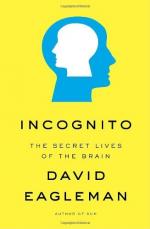
|
| Name: _________________________ | Period: ___________________ |
This test consists of 15 multiple choice questions and 5 short answer questions.
Multiple Choice Questions
1. What do newborns seem to recognize?
(a) The smell of their mothers.
(b) Their existence as separate from others around them.
(c) The feel of their mothers' skin.
(d) The sound of their mothers' voices.
2. What did Whitman indicate in some writings he left behind?
(a) He hated his father.
(b) He wanted to take others with him so he wouldn't be lonely.
(c) He was sorry he was out of control.
(d) He suspected he had something wrong with his brain.
3. What were men first shown briefly?
(a) Abstract figures.
(b) Colors lined up in various orders.
(c) Pictures of women.
(d) Pictures of cars.
4. How do some scientist define intelligence?
(a) The ability to mix emotion with thought.
(b) Many small actions that can be performed without conscious thinking coming together.
(c) The ability to think more than a couple steps ahead of a task.
(d) The ability to make very fine distinctions.
5. What does Eagleman say we cannot choose?
(a) If we want to commit a murder or not.
(b) If we want to eat that piece of pie or not.
(c) If our environment has chemical hazards that could trigger bad behavior.
(d) Our genes or who raises us.
6. What does Eagleman say is difficult?
(a) Believing that our unconscious is so aware.
(b) Believing that our unconscious is so unaware.
(c) Understanding and accepting that much of our minds is inaccessible to our conscious selves.
(d) Knowing that we have very little true free will.
7. What has a role in how genetic tendencies might be expressed?
(a) Which genes are recessive versus dominant.
(b) Whether a trigger is there to activate a bad behavior gene.
(c) A person's upbringing and environment.
(d) If the genes are from the paternal or maternal side of the child.
8. How does Eagleman answer the question about whether the actor is racist or not?
(a) The actor is definitely racist because one's true beliefs are hard to hide under the influence of alcohol.
(b) One part of his brain is racist and another part is not.
(c) The author does not say as that is not the point of his anecdote.
(d) The actor does not know himself if he is racist.
9. What does Eagleton point out in the beginning of the chapter about our senses?
(a) They are an illusion.
(b) They are limited.
(c) They only exist to serve the body.
(d) They only exist to serve the mind.
10. What are two competing aspects of the brain which Eagleman mentions?
(a) Rational and psychological.
(b) Rational and irrational.
(c) Emotional and psychological.
(d) Rational and emotional.
11. What proved difficult in programming robots?
(a) Having them be able to grasp fine particles.
(b) Having them understand the difference between two degrees of moisture.
(c) Having them perform simple tasks.
(d) Having them perform two tasks that were only minutely different.
12. For what was the actor in #109 arrested in 2006?
(a) Bad acting.
(b) Tax evasion.
(c) Driving while intoxicated.
(d) Wife abuse.
13. How does Eagleman compare the conscious mind to the senses in a human being?
(a) Both have limits.
(b) Senses do not have limits but the conscious mind does.
(c) Senses have limits but the conscious mind does not.
(d) Neither have limits.
14. At what do babies tend to look?
(a) The heart are where the sound of the heart beat is.
(b) Hands.
(c) Faces.
(d) Their own hands.
15. What culture does this actor slander?
(a) Chinese.
(b) Arab.
(c) Jewish.
(d) Mexican.
Short Answer Questions
1. What does Chapter 4 explore?
2. What does Eagleman say the majority of criminals are?
3. What studies does Eagleman look at in this chapter?
4. Who obtained a record of the arresting incident?
5. What did an autopsy of Whitman find?
|
This section contains 684 words (approx. 3 pages at 300 words per page) |

|




